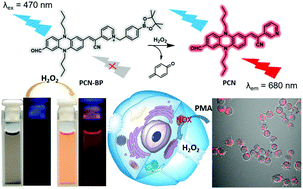A NIR fluorescent probe based on phenazine with a large Stokes shift for the detection and imaging of endogenous H2O2 in RAW 264.7 cells †
Abstract
Hydrogen peroxide (H2O2), one of the reactive oxygen species (ROS), plays vital roles in diverse physiological processes. Thus, herein, to improve the signal-to-noise ratio, a new near-infrared region (NIR) fluorophore (PCN) based on reduced phenazine was developed. PCN was further designed as a “turn on” fluorescent probe (PCN-BP) for the detection of H2O2 by introducing p-boratebenzyl. After H2O2 was added, the p-boratebenzyl group in PCN-BP was oxidized to p-hydroxy benzyl; it then self-departed, forming PCN, which displayed 24-fold NIR emission at 680 nm with a large Stokes shift (more than 200 nm). This probe presented an excellent linear relation with the concentration of H2O2 and good selectivity to various ions, ROS and biothiols; thus, it can be utilized as a colorimetric and fluorescence turn-on probe. More importantly, the probe was also employed for the exogenous and endogenous imaging of H2O2 in RAW 264.7 cells.



 Please wait while we load your content...
Please wait while we load your content...